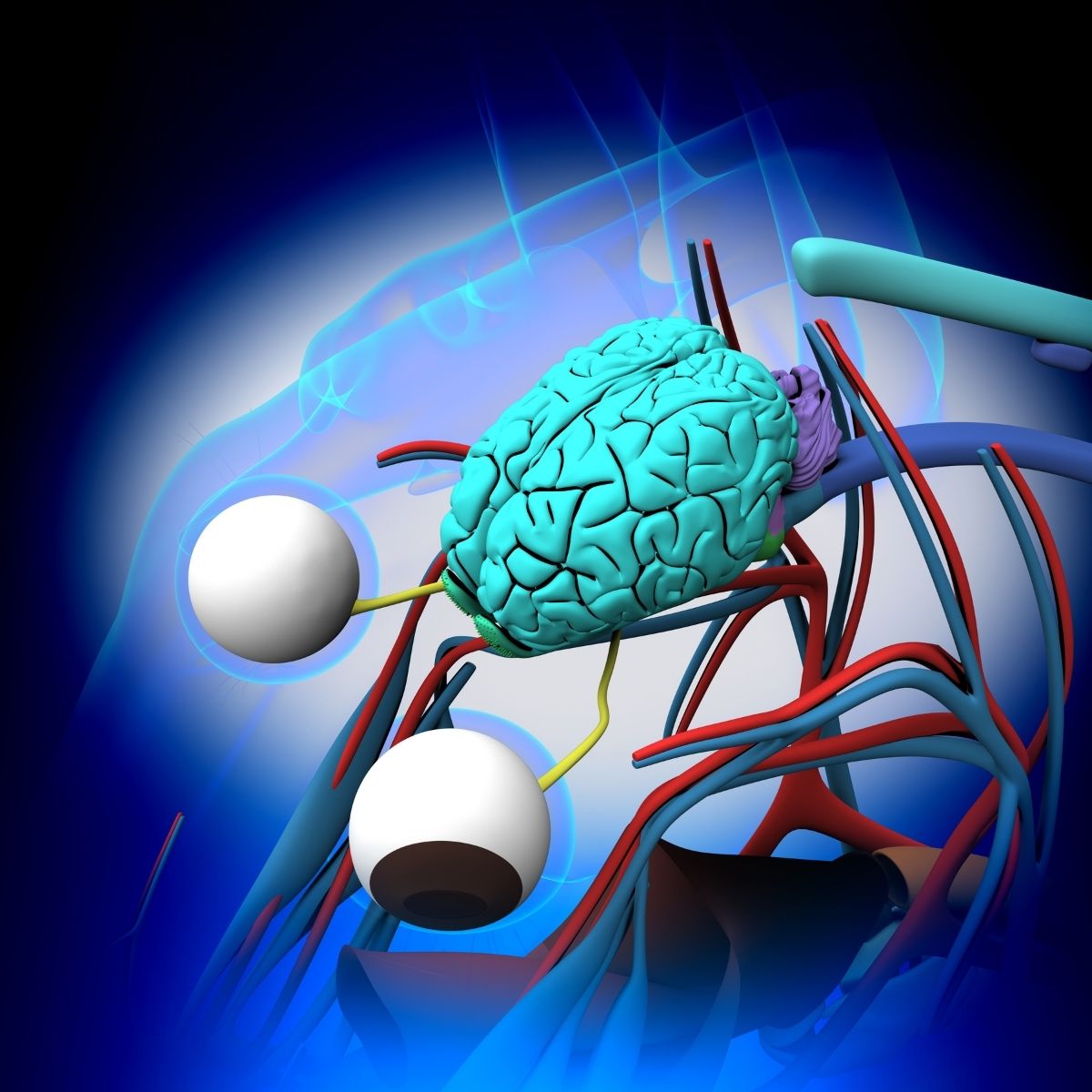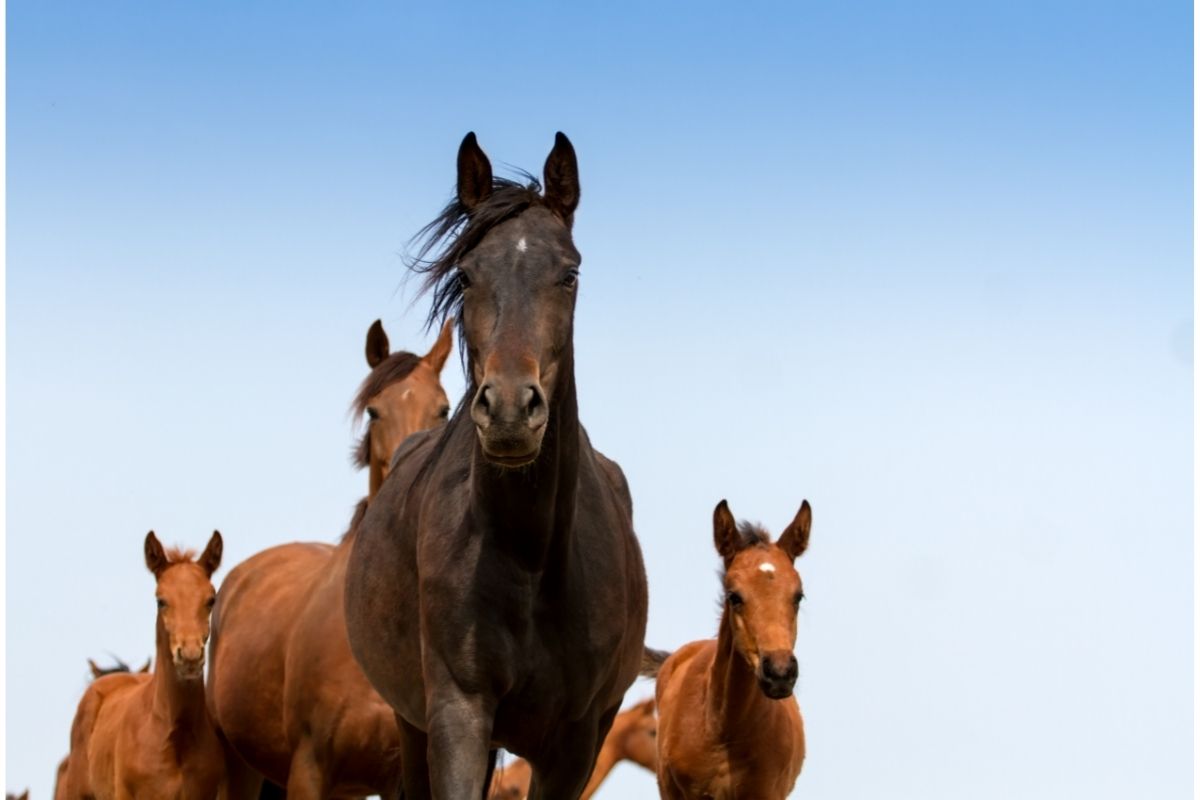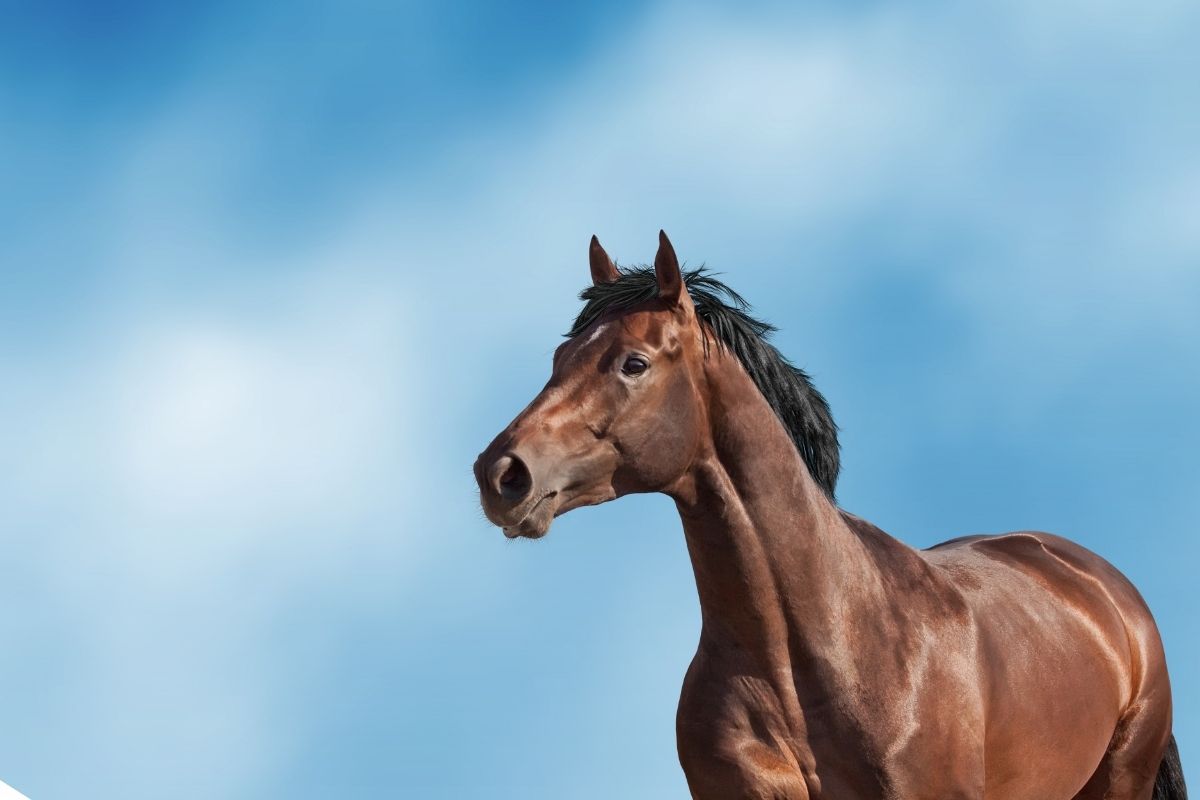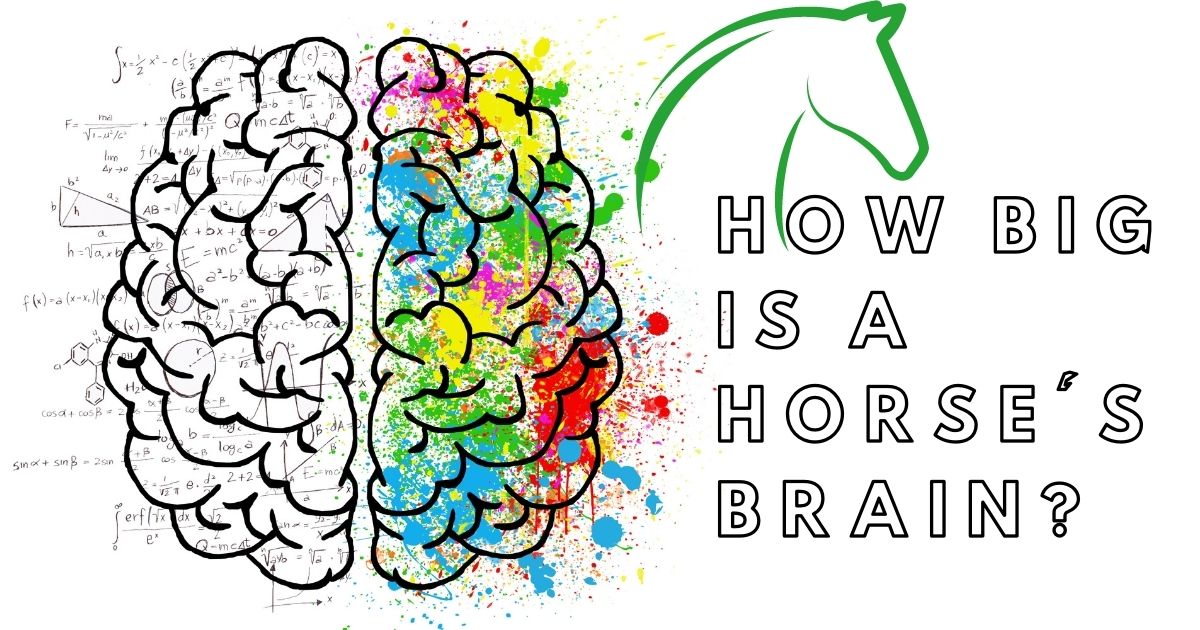The Horse Brain
How big is a horse’s brain? A horse’s skull is quite massive, and it’s simple to think that they have a vast brain inside. On the other hand, a horse’s brain is fairly small, measuring 4 to 6 inches (10 to 15 centimeters) in circumference. To put it in perspective, it’s the size of a walnut.

How Big is a Horse’s Brain?
In some ways, the brain is just the most recent element of the equine anatomy to receive attention. It’s subject to opinions about welfare, training, and psychology, positive elements.
You frequently hear that a person’s IQ is unrelated to their brain size. At the same time, in humans, a relatively large brain indicates intelligence, whereas, in horses, a brain the size of a (large) walnut explains their lack of intelligence.
Innovative activities with no evolutionary basis test the intelligence of horses. Allowing behavior-based testing methods to be set aside for the time being, how do we determine whether there is a link between different brain sizes and intelligence levels?
Equine Brain and Body Mass Measurement
In zoology, the starting point is brain mass compared to body mass or weight, not brain size.
Even then, it’s not as simple as separating the brain from the body and weighing them separately. The most precise method accounts for several anatomical and physiological parameters, including the amount of water in the brain.
The result is a single number known as the encephalization quotient (EQ). After calculating the EQ for dozens of animals, researchers arrive at the EQ for a species. The skull’s domed ‘cranial vault’ forms from the parietal bones.
So, how does the Equine Brain take this? Only a few equestrian scholars looked into EQs because it is mostly a zoological neuroanatomy field;
The brains of 131 mixed breed adult horses (no ponies) were taken and weighed in this study by Cozzi et al. (2014). According to researchers, the adult horse’s brain weighs 1.32 to 1.54 pounds (600–700 g).
Horses the age of two and up had an average brain weight of 1.33 pounds (606 g), while their average mass was 535.22 kg. This means that the EQ of the horses in this investigation was 0.78.
The EQs for some of the larger mammals are as follows: cow: 0.55; pig: 0.6; camel: 0.61; horse: 0.78; goat: 0.8; wolf: 0.9; domestic cat: 1.00; african elephant: 1.67; gorilla: 1.76; and human: 6.62.
So, do horses have intelligence, or do they not? Although comparing a bigger brain mass to body mass is frequently correlated with better cognitive functioning, this does not imply that it causes it.
As a result, brain size is a fairly broad indicator of intelligence. The exact areas of the brain and their relative sizes are important.
The larger the frontal lobes, and hence the prefrontal cortex, the more capable the species is of ‘goal-directed’ actions – the ability to analyze data and act appropriately. The horse’s frontal lobes are small, which means it is more inclined to react in the present. This isn’t to imply horses aren’t intelligent; it’s just that they think and act differently.
Rats have smoother brain surfaces than horses, despite their classification on the lowest end of the mammalian intelligence scale (although rat owners will undoubtedly disagree). Horses, on the other hand, have fewer brain fissures than primates.
The cranial vault is the area within the skull. Its inner surface is identical to the brain’s outer surface, as the two develop together as the animal matures. You could see a flawless mold of the cracks if you look inside this skull area.
Recent research also links intelligence to the structure of neurons (nerve cells) and synapses in the brain.
Isn’t there a distinction between breeds? The head forms of different horse breeds are unquestionably different.
Overall, though, the variations are minor. The proportions of the ‘neurocranium’ – the area above the frontonasal suture encompassing the skull – were quite similar between breeds in a study of TBs, STBs, and Arabians.
The lower region of the skull, particularly the nasal bones and maxilla, differ the most, giving the breeds their distinct appearances. They did not measure the skull in this investigation. The neurocranium encompasses the temporal and parietal bones and finishes at the occiput, aligning with the frontonasal suture’s ends.
While some breeds may appear very distinct, for example, the Welsh Cob and the TB, the neurocranium appears to be roughly square in all, at least when you view from the front. Even though certain breeds have relatively larger heads, all (except ponies) have EQs that cluster around the 0.78 average scores.
Small and wide ponies frequently have huge parietal domes, but the jury is still on whether this makes them more intelligent. The truth is that we have no idea. How should intelligence be defined and measured in horses and ponies?
More on the Brain Size of Horses
There are a few further undocumented distinctions. When comparing horse skulls, we can notice that some have a narrower cranium than others in terms of overall skull width. They also come in various shapes, with some being quite full and spherical and others having a more teardrop shape.
You can see this when you look at the gaps on either side of the parietal ‘dome’ and temporal bones, where the mandible’s coronoid processes protrude behind the zygomatic arch. This could be due to the breed, or it could be personal. Human skulls differ from person to person, with certain aspects innate to us and others more developing.
This is also evident in horses. Dwarf horses, as well as horses born prematurely, can have domed heads. This affects intellect in humans since IQ is lower when the brain is smaller due to developmental delays. It makes no difference if it is smaller without any developmental delays.

Are Horses as Smart as Humans?
No, comparing horse intelligence to human intelligence would be a stretch. Horses have the intelligence of a three-year-old child. These animals are capable of comprehending human emotions and learning commands and tricks.
People think that horses have a better memory than humans since they must learn about the numerous plants that surround them to determine what is edible and what is not and what tastes good and what does not.
These minor variations make this animal intelligent but not intelligent enough to match even a percent of an adult human’s IQ.
Is Horse Intelligence Equal to Human Intelligence?
Humans have lost many instinctive characteristics that horses still maintain. Horses have significantly more developed areas of the brain that control these instincts. Horses, for example, are prey animals that must always prepare to flee from predators.
As a result, the cerebellum, the brain region that controls movement and coordination, is far more developed in horses than in humans.
Other researchers studied the brain sizes of horses and humans of various ages. The result was that the horse’s brain is the size of a 12-year- old’s, with the mental capacity of a human youngster.
When you consider horses, you understand that they are intellectual in ways that humans are not. We communicate via talking, making it quite simple to convey our message. On the other hand, Horses must communicate in a variety of ways that are far more complex than our use of words.
Are Horses as Smart as People?
The region that analyzes odors is another well-developed portion of the equine brain. When a horse sniffs something, the information it may glean is far more intricate and informative than we can ever conceive. So, while we humans can create poetry and solve puzzles, we can’t tell what’s going on a mile away just by smelling the breeze.
Which Region of the Horse’s Brain is in Charge of Memory?
The limbic system is the region of the horse’s brain that handles memory. It is responsible for emotions, instincts, and memories and is in the brain’s center. The amygdala, hippocampus, hypothalamus, and thalamus are all here.
Transportation of the information is from the senses to the brain and then to the region of the brain that governs memory to learn something. This is the limbic system in horses. The sensory cortex, located directly behind the eyes, receives information from the senses.
The information then goes to the hippocampus because memory storage is in the hippocampus, a highly essential portion of the brain.
Do Horses Have Feelings?
Horses are capable of feeling both their own and your emotions. Horses, like humans, are intellectual, capable of creating profound ties with others, and have emotions.
Horses experience anger, jealously, melancholy, loss, joy, happiness, love, hate, grief, surprise, and a range of other emotions. They can also demonstrate these feelings through their activities. When you threaten them, they get angry, or when someone dies, they can be sad. The conduct of a horse reveals its individuality.
Do Horses Have the Same Intelligence as Dogs?
Horses and dogs are frequently on comparison to see if horses are more intelligent than dogs and vice versa. You can find the answer to this question in numerous studies and facts provided over time.
It is now popular that both horses and canines are capable of extraordinary feats. Many dog breeds can detect disease and guide the blind or provide emotional support to others.
On the other hand, horses are famous for their ability to retain complex patterns and, in some cases, sense impending weather. Because of these differences in capacities, comparing the intellect of these two animals can be tricky, making it difficult to say whether horses are more intelligent than dogs or vice versa.
Horses have a high emotional intelligence quotient and prophecy that is difficult to match. On the other hand, dogs are quick learners who can easily adjust to humans’ lives and make outstanding family members.
These animals have exceptional cohesive abilities that construct a picture of both horses and dogs to depict their strengths and weaknesses, making the topic of whether horses are smarter than dogs challenging to answer.
In some circumstances, the intellect of horses compares to that of cats, where the difference is that cats are predators and have a different skill set than horses.
According to scientific studies, horses learn faster than dogs but are slower problem solvers. Breeding dogs was for their intellect and ability to assist people in difficult situations. Sheepdogs and hunting dogs are excellent examples.
Even with this assertion, horses are smarter than dogs, but no accurate comparisons since they are two completely different species. Horses can recognize their names and form bonds with humans, but not the same way dogs do.
Horses are smarter based on memory testing because, as prey species, they evolve and devise clever strategies to protect themselves from predatory animals. There is no definite answer to point out which creature is smarter because there is no benchmark for animal intelligence.
Is it True That Horses are Smarter Than Cows?
Horses sometimes compare to cows in terms of intelligence, and the answer is usually simple: horses are more clever than cows.
Horses are pretty intelligent and can pick up on things and learn new tricks with proper training. Horses, unlike cows, are emotional animals with the ability to learn and grow, as well as a bond with humans.
Understanding the Mind of Your Horse
People sometimes question “how big is a horse’s brain” when they consider the level of intelligence and pride with which a horse conducts itself. It’s normal to be curious about how a horse’s brain works. There are ideas that the brain’s weight affects IQ. Understanding equine brain anatomy can help you better understand horses.
According to the Equine Behavioral Health Resource Center (EBHRC), the size of a horse’s brain is comparable to that of a toddler or the size of a grapefruit. Even though the human brain is larger, several functions are very comparable.
Humans have a stronger thinking capacity because their brain size to body mass ratio influences cognitive skills. On the other hand, a horse’s brain focuses on physical functions, muscle coordination, and balance.
Horses are prey animals and are born ready to hunt. The cerebellum is the part of the brain that controls coordination, perception, and motor movements in all mammals.
Let’s look at the cerebellum to see how big a horse’s brain is. Because it adapts to a predatory environment, the cerebellum of an equine brain is larger than that of a human. It must learn to survive right after birth, which requires coordination of its legs and the ability to adapt to its surroundings.
The brain of a horse is a reptile. This is the area of the brain that ensures the brain’s survival. During survival, it is the portion that activates flight, fight, and freeze. The animal’s brain cannot learn anything else while experiencing these responses. Before teaching an animal anything, you need to get it in the appropriate frame of mind.
Intelligence of Horses
The empirical proof that horses have some cognitive capacity refutes the popular belief that they can merely respond to conditioned stimuli. Horses can create concepts and solve cognitive difficulties to a certain extent.
A horse in the wild must contend with the unpredictability of several predators. A domesticated animal must learn to adapt to an artificial habitat and live with people while knowing the duties of each individual, from the parent to the trainer.
Horses have excellent senses, which allow them to move around their surroundings. Horses rely on their feelings and sensations since they lack the aptitude for deductive reasoning that humans possess. As a result, infants learn through associating specific actions and behaviors with gestures and cues.
When an animal hears the squeaking of cartwheels, for example, it knows it’s time to eat since it’s aware and associates these noises with hay. Through repetition, this pet develops these connections. For this reason, trainers regularly use body language to teach the animal how to respond.
Understanding how a horse’s brain affects its behavior is more important than simply knowing the horse’s brain size. Horses have unique problems in terms of handling, but once you understand how they think, you can alter your strategies. Because humans and horses behave differently, human-centric perceptions can interfere with your horse training.
You can explain equine behavior using terms like right-brained, which refers to the primary use of the survival side of the brain, and left-brained, which refers to the use of the emotional side of the brain. You can have fun as a horse parent if you know your horse.

Summary
How big is a horse’s brain? There isn’t much information available to help us figure out what factors influence the size of a horse’s brain. The most evident distinction is the horse’s size: smaller horses have smaller brains. However, this does not impact the animal’s overall intellect. Ponies are frequently more clever than horses.
Evolution is one element impacting the size of the horse’s brain. Amazingly, the brains of horses are shrinking. Horses’ brains are shrinking by up to 16 percent over a long time. It is impossible to determine why it happened.
Horse domestication points out as a critical factor. They don’t have to think as much for themselves any longer. Another theory is that horse breeding to maintain features results from a steady shrinking of the brain size.
When comparing domesticated horses’ brains to wild horses’ brains, the wild brains are up to 30% larger. This isn’t to say that your domesticated horses aren’t as intelligent as their wild counterparts. This shrinkage of the brain is most likely because they no longer require the components of the brain that allow them to thrive in the wild.
It’s unclear whether the size of a creature’s brain affects its intellect. Some experts believe that increasing the size of the brain in relation to the body promotes intellect, whereas others disagree.
A horse’s brain size compared to human brain is smaller than a human’s brain, even though the horse is a larger animal. A horse’s brain weighs roughly 0.1 percent of its total body weight, while the human brain weighs 2 percent. Does this, however, imply that humans are smarter than horses?
Intelligence assessment happens in a variety of ways. Although humans are the dominant species, this does not imply that we are more intelligent than horses.
